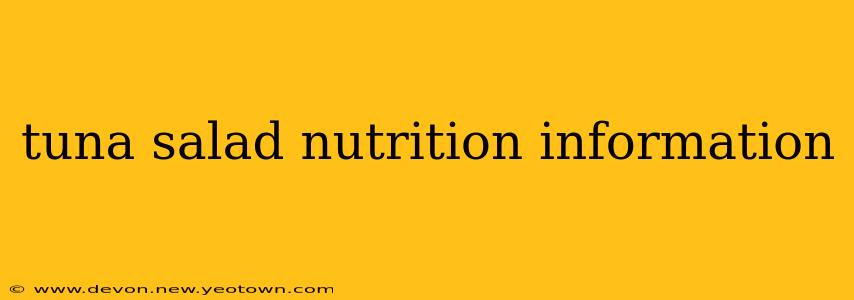Tuna salad. The name conjures up images of crisp lettuce, juicy tomatoes, and the satisfying chunkiness of tuna nestled within a perfectly toasted bread. But beyond the taste, what's truly in that tuna salad? Let's dive deep into the nutritional information of this beloved lunchtime staple, exploring its caloric content, macronutrient breakdown, and surprising health benefits. This isn't just a quick rundown; we're going on a culinary nutrition adventure!
What are the Calories in Tuna Salad?
This is the million-dollar question, isn't it? The calorie count of tuna salad is highly variable. It depends heavily on several factors: the type of tuna used (canned in water vs. oil), the amount of mayonnaise (or other creamy additions), and the inclusion of extra ingredients like celery, onion, or even extra crunchy additions.
A typical serving of tuna salad (about ½ cup) made with canned tuna in water and a moderate amount of mayonnaise can range from 200 to 300 calories. However, if you're using oil-packed tuna or a generous helping of creamy dressing, that number can easily climb above 400 calories. Remember, those extra additions like croutons or cheese quickly add to the overall calorie count! To keep it light and healthy, opt for tuna packed in water and use a light mayonnaise or Greek yogurt alternative.
Is Tuna Salad Healthy?
The healthfulness of tuna salad hinges on the ingredients and portion size. At its core, tuna is an excellent source of lean protein, rich in omega-3 fatty acids. These healthy fats are beneficial for heart health, brain function, and reducing inflammation in the body. However, mayonnaise, a staple in many tuna salad recipes, is high in fat and calories.
The key to a healthier tuna salad lies in mindful ingredient choices. Opt for:
- Tuna packed in water: This significantly reduces the fat content compared to oil-packed tuna.
- Reduced-fat mayonnaise: Using a light mayonnaise or a healthier alternative like Greek yogurt can drastically cut down on calories and unhealthy fats.
- Plenty of vegetables: Adding celery, onion, bell peppers, or other vegetables increases the fiber and nutrient content, making the salad more filling and nutritious.
What are the Macronutrients in Tuna Salad?
Let's break down the essential macronutrients (protein, carbohydrates, and fats) found in a typical tuna salad serving:
-
Protein: Tuna is a powerhouse of protein, providing a significant contribution to your daily protein intake. This is crucial for building and repairing tissues, supporting muscle growth, and keeping you feeling full and satisfied.
-
Carbohydrates: The carb content primarily comes from any added ingredients like bread or crackers. If you're watching your carb intake, consider serving your tuna salad over a bed of greens or with celery sticks instead of bread.
-
Fats: The fat content largely depends on the type of tuna and the amount of mayonnaise used. Choosing tuna packed in water and reducing the mayonnaise will keep the fat content under control.
How Much Protein is in Tuna Salad?
The protein content will vary depending on the amount of tuna used, but a typical serving of tuna salad can provide around 15-20 grams of protein. This makes it a satisfying and protein-rich meal or snack, contributing significantly to your daily protein needs.
What are the Benefits of Eating Tuna Salad?
Beyond its protein content, tuna salad offers several potential health benefits:
-
Heart Health: The omega-3 fatty acids in tuna can help lower blood pressure and reduce the risk of heart disease.
-
Brain Function: Omega-3s are also crucial for brain health and cognitive function.
-
Weight Management: When made with healthy ingredients and portioned appropriately, tuna salad can be part of a weight-management plan due to its protein content, which promotes satiety.
Is Tuna Salad Good for Weight Loss?
Tuna salad can be good for weight loss, provided it's prepared mindfully. By choosing lean tuna, reducing the mayonnaise, and adding plenty of vegetables, you can create a relatively low-calorie, high-protein meal that keeps you feeling full and satisfied without sabotaging your weight loss goals. However, portion control remains key!
Remember, moderation and mindful ingredient choices are key to enjoying the deliciousness of tuna salad while reaping its nutritional benefits. So go ahead, savor that sandwich—but remember the power of mindful eating!

